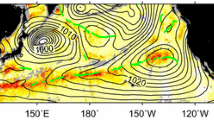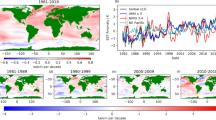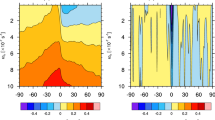Abstract
The relationship between sea surface temperature (SST) and net heat flux (NHF) in the North Pacific over weekly to annual period bands was investigated using gridded datasets of SST obtained by the Advanced Microwave Scanning Radiometer for the Earth Observing System, and flux data produced by the Modern-era Retrospective-analysis for Research and Applications Reanalysis. This study focused on the phase difference between the SST and NHF, which can suggest the driving force between two co-varying parameters. The SST delay behind the NHF, with phase differences from π/4 to π/2, which suggests that the SST change would be controlled by the NHF, was commonly found over all periods. In the intra-annual (100- to 200-day periods) band, part of the coherent variations showed negative phase differences (around −π to −π/3), which were found in the western North Pacific and along ∼30°N in the central North Pacific. The spatial scales of SST variability in the shorter band (weekly to intraseasonal: less than 100-day periods) are dominantly over 200 km. In contrast, the scales in the intra-annual band were in the range 50–150 km, where the negative phase differences were frequently found.









Similar content being viewed by others
References
Adamec D (1998) Modulation of the seasonal signal of the Kuroshio Extension during 1994 from satellite data. J Geophys Res 103:10209–10222
Bilmes J (1998) A gentle tutorial on the EM algorithm and its application to parameter estimation for Gaussian mixture and hidden Markov models. Technical report, Technical Report ICSI-TR-97-02. University of Barkley
Brunke MA, Wang Z, Zeng X, Bosilovich M, Shie C-L (2011) An assesment of the uncertainties in ocean surface turbulent fluxes in 11 reanalysis, satellite-derived, and combined global datasets. J Clim 24:5469–5493
Cayan DR (1992) Latent and sensible heat flux anomalies over the Northern Oceans: driving the sea surface temperature. J Phys Oceanogr 22:859–881
Chou C, Hsueh Y-C (2010) Mechanisms of northward-propagating intraseasonal oscillation—a comparison between the Indian Ocean and the western North Pacific. J Clim 23:6624–6640
Deser C, Timlin MS (1997) Atmosphere–ocean interaction on weekly timescales in the North Atlantic and Pacific. J Clim 10:393–408
Ebuchi N, Hanawa K (2000) Mesoscale eddies observed by TOLEX/ADCPand TOPEX/POSEIDON altimeter in the Kuroshio recirculation regionsouth of Japan. J Oceanogr East Pac 56:43–57
Emery WJ, Thomson RE (2001) Data analysis methods in phisical oceanography, 2nd and revised edn. Elsevier, Amsterdam
Eyre J, Andersson E, Charpentier E, Ferranti L, Lageuille J, Ondras M, Pailleux J, Rabier F, Riishojgaard LP (2009) Requirements of numerical weather prediction for observations of the oceans. In: Hall J, Harrison D, Stammer D (eds) Proceedings of OceanObs’09: Sustained Ocean Observations and Infromation for Society, vol 2. ESA Publication WPP-306. Venice, Italy. doi:10.5270/OceanObs09.cwp.26
Frankignoul C, Kestenare E (2002) The surface flux feedback. Part I: estimate from observations in the Atlantic and the North Pacific. Clim Dyn 19:633–647
Fu R, Liu WT, Dickinson RE (1996) Responce of tropical clouds to the interannual variation of sea surface temperature. J Clim 9:616–634
Gill AE, Turner JS (1976) A comparison of seasonal thermocline modles with observation. Deep Sea Res 23:391–401
Grinsted A, Moore JC, Jevrejeva S (2004) Application of the cross wavelet transform and wavelet coherence to geophysical time series. Nonlinear Proc Geophys 11:561–566
Guan L, Kawamura H (2004) Merging satellite infrared and microwave SSTs: methodlogy and evaluation of the new SST. J Oceanogr 60:905–912
He R, Weisberg RH, Zhang H, Muller-Karger FE, Helber RW (2003) A cloud-free, satellite-derived, sea surface temperature analysis for the West Florida Shelf. Geophys Res Lett 30. doi:10.1029/2003GL017673
Hickey BM (1989) Patterns and processes of circulation over the Washington continental shelf and slope. In: Landry M, Hickey B (eds) Oceanography of the Washington–Oregon coastal zone. Elsevier, Amsterdam, pp 41–109
Hosoda K (2010) A review of satellite-based microwave observations of sea surface temperatures. J Oceanogr 66:439–473
Hosoda K, Kawamura H (2004) Global space-time statistics of sea surface temperature estimated from AMSR-E data. Geophys Res Lett 31. doi:10.1029/2004GL020317
Hosoda K, Kawamura H (2005) Seasonal variation of space/time statistics of short-term sea surface temperature variability in the Kuroshio region. J Oceanogr 61:709–720
Iwasaki S, Kubota M, Tomita H (2008) Inter-comparison and evaluation of global sea surface temperature products. Int J Remote Sens 29:6263–6280
Kashima M, Ito S-I, Ichikawa K, Imawaki S, Umatani S-I, Uchida H, Setou T (2009) Quasipediodic small meanders of the Kuroshio off Cape Ashizuri and their inter-annual modulation caused by quasioediodic arrivals of mesoscale eddies. J Oceanogr 65:73–80
Kawai Y, Kawamura H, Takahashi S, Hosoda K, Murakami H, Kachi M, Guan L (2006) Satellite-based high-resolution global optimum interpolation sea surface temperature data. J Geophys Res 111. doi:10.1029/2005J003313
Kobashi F, Kawamura H (2001) Variation of sea surface height at periods of 65–220 days in the subtropical gyre of the North Pacific. J Geophys Res 106:26817–26831
Konda M, Imasato N, Shibata A (1996) Analysis of the global relationship of biennial variation of sea surface temperature and air–sea heat flux using satellite data. J Oceanogr 52:717–746
Liu WT, Zhang A, Bishop JKB (1994) Evaporation and solar irradiance as regulators of sea surface temperature in annual and interannual changes. J Geophys Res 99:12623–12637
McClain EP, Pichel WG, Walton CC (1985) Comparative performance of AVHRR-based multichannel sea surface temperatures. J Geophys Res 90:11,587–11,601
Murakami H, Kawamura H (2001) Relations between sea surface temperature and air–sea heat flux at periods from 1 day to 1 year observed at ocean buoy stations around Japan. J Oceanogr 57:565–580
Pelleg D, Moore A (2000) X-means: extending K-means with efficient estimation of the number of clusters. In: Proc. 17th International Conference on machine learning (ICML’00). pp 727–734
Reynolds RW, Smith TM (1994) Improved global sea surface temperature analyses using optimum interpolation. J Clim 7:929–949
Reynolds R, Rayner NA, Smith TM, Stokes DC, Wang W (2002) An improved in situ and satellite SST analysis for climate. J Clim 15:1609–1625
Reynolds RW, Smith TM, Liu C, Casey DBCKS, Schlax MG (2007) Daily high-resolution-blended analyses for sea surface temperature. J Clim 20:5473–5496
Rienecker MM, Suarez MJ, Gelaro R, Todling R, Bacmeister J, Liu E, Bosilovich MG, Schubert SD, Takacs L, Kim G-K, Bloom S, Chen J, Collins D, Conaty A, da Silva A, Gu W, Joiner J, Koster RD, Lucchesi R, Molod A, Owens T, Pawson S, Redder PPCR, Reichle R, Robertson FR, Ruddick AG, Sienkeiwicz M, Woollen J (2011) MERRA: NASA’s modern-era retrospective analysis for research and applications. J Clim 24:3624–2648
Sakaida F, Kawamura H, Takahashi S, Shimada T, Kawai Y, Hosoda K, Guan L (2009) Research, development, and demonstration operation of the new generation sea surface temperature for open ocean (NGSST-O) product. J Oceanogr 65:859–870
Sakurai T, Kurihara Y, Kuragano T (2005) Merged satellite and in-situ data global daily SST. In: Proceedings of 2005 IEEE International geoscience and remote sensing symposium, IGARSS ’05, vol 4. pp 2606–2608
Schmeits MJ, Dijkstra HA (2002) Subannual variability of the ocean circulation in the Kuroshio region. J Geophys Res 107. doi:101029/2001JC0011073
Schwarz GE (1978) Estimating the dimension of a model. Ann Stat 6:461–464
Shibata A (2004) AMSR/AMSR-E SST algorithm developments—removal of ocean wind effect. Italian J Remote Sens 30/31:131–142
Shibata A (2006) Features of ocean microwave emission changed by wind at 6 GHz. J Oceanogr 62:321–330
Shibata A (2007) Effect of air–sea temperature difference on ocean microwave brightness temperature estimated from AMSR, SeaWinds, and buoys. J Oceanogr 63:863–872
Shinoda T, Hendon HH, Glick J (1998) Intraseasonal variability of surface fluxes and sea surface temperature in the tropical western Pacific and Indian Oceans. J Clim 11:1685–1702
Sugimoto S, Hanawa K (2011) Roles of SST anomalies on the wintertime turbulent heat fluxes in the Kuroshio–Oyashio confluence region: influences of warm eddies detached from the Kuroshio Extension. J. Clim 15:6551–6561
Tanimoto Y, Nakamura H, Kagimoto T, Yamane S (2003) An active role of extratropical sea surface temperature anomalies in determining anomalous turbulent heat flux. J Geophys Res 108. doi:10.1029/2002JC001750
Thorpe SA (2007) An Introduction to ocean turbulence. Cambridge University Press, Cambridge
Tokinaga H, Tanimoto Y, Xie S-P, Tomita H, Ichikawa H (2009) Ocean frontal effects on the vertical development of clouds over the western North Pacific: in situ and satellite observations. J Clim 22:4241–4260
Torrence C, Compo G (1998) A practical guide to wavelet analysis. Bull Am Meteorol Soc 79:61–78
Torrence C, Webster PJ (1999) Interdecadal changes in the ENSO-monsoon system. J Clim 12:2679–2690
Vallis GK (2006) Atmospheric and oceanic fluid dynamics: fundamentals and large-scale circulation. Cambridge University Press, Cambridge
Wallace JM, Smith C, Jiang Q (1990) Spatial patterns of atmosphere–ocean interaction in the northern winter. J. Clim 3:990–998
Wang C, Enfield DB (2001) The tropical western hemisphere warm pool. Geophys Res Lett 28:1635–1638
Wang L, Li T, Zhou T (2012) Intraseasonal SST variability and air–sea interaction over the Kuroshio Extension region during boreal summer. J Clim 25:1619–1634
Warren BA (1976) Insensitivity of subtropical mode water characteristics to meteorological fluctuations. Deep Sea Res 19:1–19
Wu R, Kinter JL III (2010) Atmosphere–ocean relationship in the midlatitude North Pacific: seasonal dependence and east–west contrast. J Geophys Res 115. doi:10.1029/2009JD012579
Acknowledgements
The author would like to express gratitude to members of physical oceanographic and satellite oceanographic groups in Tohoku University for their helpful comments and advices. Two anonymous reviewers gave valuable comments and suggestions to significantly improve this manuscript. The Japan Aerospace Exploration Agency (JAXA) Earth Observation Research Center (EORC) is thanked for providing AMSR-E SST data. The Global Modeling and Assimilation Office (GMAO) and the GES DISC are thanked for for the dissemination of MERRA heat flux data.
Author information
Authors and Affiliations
Corresponding author
Appendix: Difference between Reynolds OISST and AMSR-E un-filtered SST
Appendix: Difference between Reynolds OISST and AMSR-E un-filtered SST
The MERRA used weekly- and 1°-resolution OISST product of Reynolds et al. (2002) for boundary condition of the ocean surface. It is suggested that the low resolution with optimal interpolation using large de-correlation scales would blur mesoscale structures of ocean surface. Figure 10 shows the spatial distributions of root-mean-square difference (RMSD) between Reynolds OISST and AMSR-E SST. The SST differences were calculated using data from January 1, 2003 to December 31, 2010. The 3-day running mean were adopted for AMSR-E SST to fulfill the gaps in the dataset. Two Reynolds OISST datasets were compared with the AMSR-E SST: (1) the previous version Reynolds OISST (RSST02; Reynolds et al. 2002, weekly, 1° resolution), which was used for boundary condition in MERRA, and (2) the latest version Reynolds OISST based on blended AVHRR and AMSR-E (RSST07; Reynolds et al. 2007, daily, 0.25° resolution). For RSST02, nearest-neighbor method was adopted for interpolating low-resolution SST data into AMSR-E grid (daily, 0.25°) before comparison. Large differences between RSST02 and AMSR-E SST, which were up to 2.0°C, were found in the western North Pacific, especially at the northern side of the SST fronts (the Kuroshio in the eastern China Sea, subarctic front in the Japan Sea, and Kuroshio/Oyashio Mixed Water Region). Even if the monthly averaging without spatial smoothing was adopted for both RSST02 and AMSR-E SST datasets, these SST differences in the western North Pacific were reduced by only 0.2–0.4°C (figure not shown). Therefore, it is suggested that the difference would be due to low spatial resolution in RSST02, which might affect the estimation of flux variability even in low-frequency bands.
In the comparison between RSST07 and AMSR-E SST, these differences were reduced to 1.0°C or less. It could be expected that the atmospheric reanalysis products using the AMSR-E and AVHRR blended RSST07 would improve their estimation of ocean surface fluxes in the near future.
Rights and permissions
About this article
Cite this article
Hosoda, K. Local phase relationship between sea surface temperature and net heat flux over weekly to annual periods in the extratropical North Pacific. J Oceanogr 68, 671–685 (2012). https://doi.org/10.1007/s10872-012-0127-7
Received:
Revised:
Accepted:
Published:
Issue Date:
DOI: https://doi.org/10.1007/s10872-012-0127-7





